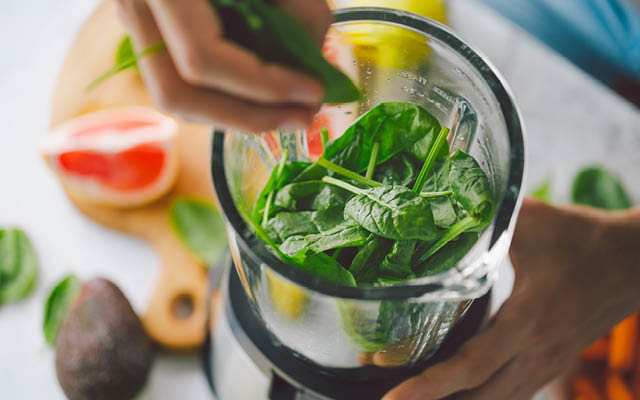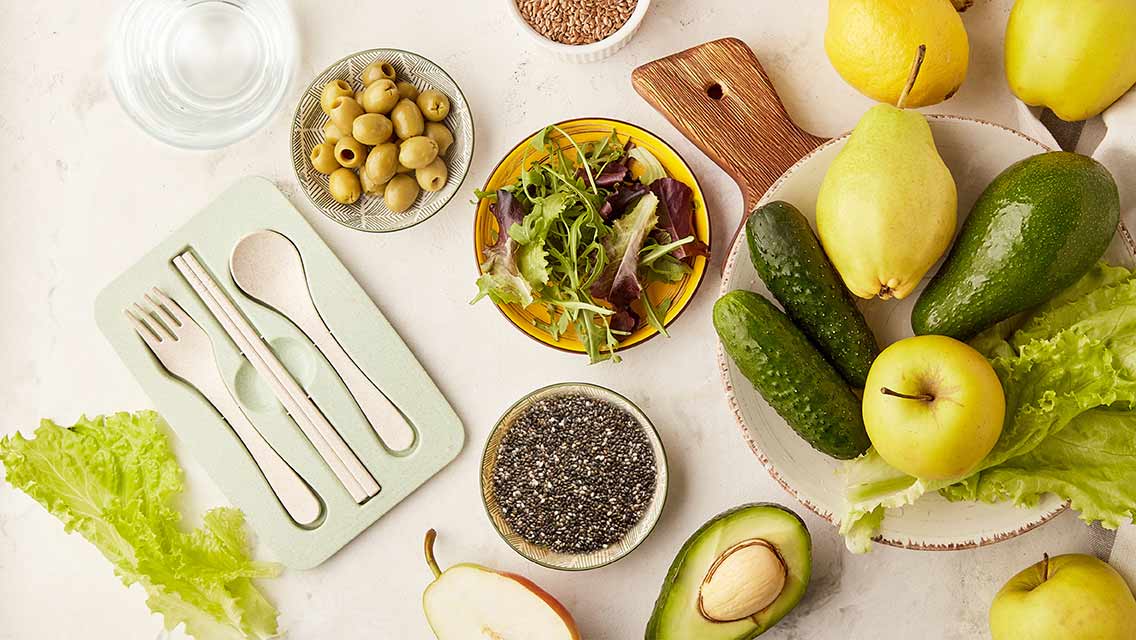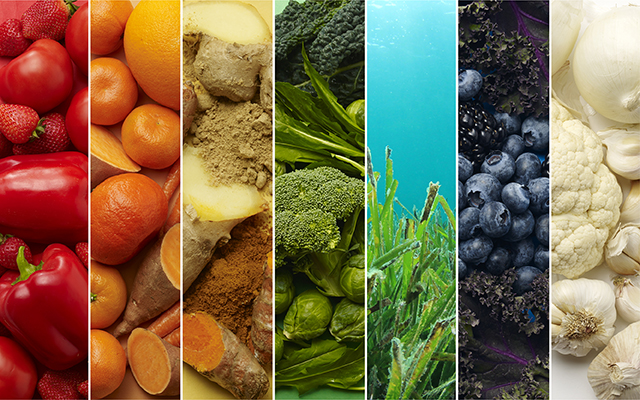Explore this article:
- Why Detox?
- The Benefits of a Detox
- Care and Commonsense Caution
- Tips to Prepare for a Detox
- Easy, Everyday Detox
- Overcoming Common Detox Side Effects
Everything seems possible in spring. It’s the season of hope, of fresh life and new beginnings. It’s also the perfect time to turn over a fresh leaf and embark on a detox plan!
Over the winter months, some of us may have overindulged in food and drink. Perhaps we let our exercise program slide, got cooped up in stuffy buildings, or got waylaid by a string of nasty colds. Whatever the reason, by early spring, relatively few of us are feeling our absolute best. Undertaking a detox now can change all that, and help put you in perfect form for the year ahead.
On an energetic and esoteric level, spring is the ideal time for cleansing. In the Chinese system, spring is linked with the element of Wood, which encourages us to try new things, to set a new course, to find new ways, to commit to action. It’s an open, energetic, enthusiastic feeling, so even if you’ve never detoxed before, this could be the perfect time, and the perfect way to start feeling better fast.
Keep in mind, however, that detoxing is not a permanent, one-time, quick fix. To maintain good health, you need to follow a sensible ongoing program of diet and exercise. You should also be prepared to take a good hard look at your whole lifestyle, environment, home – and, yes, your mind and emotions, too. I believe that one of the biggest toxins in our lives (one that ages us more than most anything) is stress.
The good news is that the latest research seems to indicate that effective detoxing need not involve draconian diets or endless fasting. Slow and gentle does the trick.
Why Detox?
Some critics say that detoxing simply isn’t necessary, that our bodies are designed to detox all by themselves quite naturally. While that is undoubtedly true in an ideal world, sadly, we don’t live in that ideal world. In fact, our modern world is incredibly toxic. We’re regularly assaulted by pollution in the air, in our homes, in the foods we eat and the clothes we wear. Our livestock are treated with drugs; our crops are sprayed with powerful pesticides and fungicides, many of which have unpleasant side effects.
Once you start learning about toxins, it’s easy to get a bit overwhelmed: Ack! Toxins, toxins, everywhere! No doubt, it is a troubling situation – but don’t panic. Recognize and accept that it is impossible and impractical to avoid every single toxin. Do what you can to avoid the worst and then focus on building up your body’s natural defenses: a strong, well-functioning immune system, good circulation and a powerful elimination system. These combined forces can deal aptly with the majority of nasties.
Beyond detoxing our bodies to clear these toxins from our own systems, those of us who are concerned about our health and the health of our children can also take larger, further-reaching actions. We can campaign for cleaner food and a cleaner environment. We can create a market for affordable organic food by asking for it and buying it whenever we can. (The more land dedicated to organic farming, the fewer chemicals poured into our soil, water and food supplies, and the fewer that end up in our bodies.) We can minimize our use of conventional paints, chemicals and cosmetics, and instead look into the increasingly wide range of nontoxic, eco- and people-friendly choices. (For more on choosing healthy personal care products, read “A Good Long Look.”) Above all, we can start understanding that we create the world we live in, and that its health dictates our own.
The Benefits of a Detox
Most of the evidence for detoxing comes from naturopathy, a system of natural medicine practiced (with very good results) for more than a hundred years. Janine Leach of the British Naturopathic Association admits that more research on detoxing is “urgently needed” but asserts that there is already “more formal evidence than you might imagine” to support detoxing’s benefits. A recent study reported in the Scandinavian Journal of Rheumatology found a “clinically significant beneficial long-term effect” for people with rheumatoid arthritis.
Even if the clinical evidence for detoxing is still forthcoming, the list of well-known potential benefits is enormous. Depending on your previous level of toxicity, you might be surprised to find a whole array of health problems simply disappear.
- Bloating, nausea, indigestion and a furred tongue could vanish as your liver gets back to optimum function.
- Constipation, gas and cramping could be a thing of the past as your intestines return to balance.
- Frequent colds and flu, tiredness, cellulite, blemishes and puffy eyes could all be banished as your lymphatic system shifts into a higher gear.
- Clogged sinuses, congestion and nasal drip can disappear when your lungs function properly.
- Urinary problems could clear up as your kidneys stop overworking and under-functioning.
“Cleansing the body helps with all sorts of health problems,” asserts naturopath Sarah Bowles Flannery. “Most people who detox experience a marked increase in energy. Often they see a clearer complexion and sparkling eyes. Concentration and mood are improved when you get rid of toxins that may have been affecting brain function and memory. Generally, you can count on feeling much more clear-headed.”
Care and Commonsense Caution
If you’re new to detoxing, it’s well worth going to a good spa or center specializing in detox programs. There is something comforting about being surrounded by a group of people going through the same process. Having food prepared for you (and not having to prepare it for anyone else) is a huge boon. Also, the staff in charge of the detox will be familiar with any short-term side effects and be able to offer suggestions for counteracting them.
If you have any chronic health problems, you should detox under supervision and with the approval of your physician. If you decide to detox on your own, then prepare carefully.
If you have any chronic health problems, you should detox under supervision and with the approval of your physician. If you decide to detox on your own, then prepare carefully. Check first with your physician and/or natural-health practitioner and pick your program. Err on the side of caution. For example, fasting is distinctly not advised if you are pregnant or breast-feeding. Some forms of detox would be dangerous if you were diabetic, or might be unsuitable if you suffer from high blood pressure or arthritis. Those with eating disorders should never approach detoxing without professional supervision.
Some other practical considerations: If possible, choose a time for detoxing when you have a lighter-than-average schedule and no pressing work or family commitments. You should always aim to detox your mind as well as your body, and in an ideal world you would spend your days meditating, reading, practicing yoga or being in nature rather than hanging on the phone or being hunched over a laptop. That said, it is possible to detox and still go about your daily business, so don’t put it off simply because you don’t see a big break in sight. Just do your best to minimize distractions and maximize your rest and recovery time. Your body will be doing some intensive healing and will appreciate all the support you can give it.
Kits and Potions
Visit any drugstore or health shop and you’ll be knee-deep in detox aids. Check into any spa and you’ll be offered an array of services aimed at soaking and squeezing out toxins. But do you really need all those pills and potions, wraps and kits? Well, some of them are certainly helpful and supportive, but frankly, no, they are not strictly necessary.
Detoxing is actually quite simple: It’s a natural, pre-programmed process that your body conducts on its own. So the non-commercial (and perhaps unpalatable) truth is that you really need to do the work yourself – with diet, exercise and will-power.
Detoxing is actually quite simple: It’s a natural, pre-programmed process that your body conducts on its own.
Given this, why the rush on all the detox-oriented products and services?
Well, while you are detoxing, your body has to cope with a vastly increased amount of toxins being released from the cells, so free-radical quenchers and herbal liver supports can be enormously helpful in increasing your body’s own detoxing efficiency and protecting your tissues from extra stress. Many people like to include a detox tea as part of their program for this reason. However, herbs and supplements should ideally be individually tailored to your specific needs. Overdosing on them, or taking the wrong ones for your individual needs, can cause unpleasant side effects and even interfere with your body’s detox process.
For this reason, I would heartily recommend that you seek the advice of a professional nutritional therapist, herbalist or naturopath before you proceed with your detox plan. He or she can work out a precise prescription, given your medical history, diet, detox priorities and various lifestyle factors.
Various kinds of bodywork, such as massage and hydrotherapy, can also benefit detoxing because they promote circulation and encourage your body’s tissues to release toxins. Plus, bodywork feels great, and its deeply relaxing effect helps the body heal more efficiently. I often recommend a form of gentle massage known as Manual Lymphatic Drainage (MLD) (see “DIY Facial Lymphatic Massage” for a quick how-to).
Certain aromatherapy oils can also assist with the detox process. However, I can’t emphasize this enough: None of these things will do it on its own, so please think of massages, wraps, soaks, supplements and elixirs not as alternatives – but rather as adjuncts – to more primary diet and lifestyle adjustments. Your biggest aid in detoxing is clear intent and commitment.
Tips to Prepare for a Detox
There are many, many different ways to detox. In my book The Detox Plan for Body, Mind, and Spirit I outline an introductory weekend detox and a more in-depth, month-long, deep-life cleanse. And there are dozens of other good detox books out there. But here I’m going to give you a special, simple springtime program based on the latest detox research. It is safe, sensible and supports all the main detox systems of the body. If you have any special health challenges or concerns, check with your health practitioner. Otherwise, aim to follow it for at least a week. In fact, the longer you stay on it, the better – it’s a blueprint for healthy living.
- Eliminate the following from your diet entirely: alcohol; caffeine (tea, coffee, sodas, etc.); dairy products; wheat; red meat (including ham, sausage, etc.); convenience, processed, “junk” and “fast” foods (including ready-meals); sugar. Don’t panic – this (surprisingly) leaves you with a large choice of good food.
- Eat lots of fresh fruit and vegetables. Make fresh soups, salads, spring stews and stir-fries. Fruit and vegetable juices, especially beetroot, broccoli and celery, are ideal for detoxing, so try to juice your own whenever possible. Choose organic produce if you can (to cut out pesticides and other chemicals). Use only a limited amount of sea salt in your flavoring; natural herbs and spices are fine, but avoid commercial seasoning mixes, which may contain sodium and other flavor additives.
- Have two or three servings of protein a day of deep-water fish, organic eggs and chicken, soy products and legumes. Grill or poach fish or chicken, or incorporate any of the above in salads and stews. Nutritional therapist Linda Lazarides, author of The Amino Acid Report suggests you incorporate some Brazil nuts and sunflower seeds, all of which contain vital detox amino acids (and which make great snacks). Avoid peanuts unless you are certain you have no sensitivities to them.
- Instead of standard tea or coffee, drink caffeine-free herbal teas (nettle or fennel are especially good choices) and/or dandelion coffee, which is liver-supporting. Some detox experts recommend green tea, which is rich in antioxidants, but be aware that it contains some caffeine.
- Replace breakfast with two tablespoons of organic maple syrup mixed with two tablespoons of freshly squeezed lemon juice, half a pinch of cayenne pepper and at least half a pint of warm water. (This mixture is the basis of a very simple and effective spring fast known as the “Masters’ Cleanse.”)
- Drink eight glasses of still (not carbonated) water a day – more if you are exercising – to help flush your kidneys and digestive system. Hot water is used extensively for detoxing in the ancient Indian system of ayurveda, and although it may sound unappealing, it can be quite pleasant, particularly with a little lemon. Fill a thermos and keep it on your desk.
- Ideally, visit a medical herbalist, naturopath or nutritional therapist who can help you devise an ideal program of supportive supplements. If you can’t do this, buy a good-quality milk thistle and echinacea product and take a short course of it while you are cleansing. Also take a quality probiotic supplement (packed with “good” bacteria like Lactobacillus acidophilus and Bifidobacterium) to support the digestive tract.
- Brush skin daily for five minutes before your shower or bath. It stimulates the flow of lymph and promotes good circulation. Use either a damp washcloth with a bicarbonate and salt mixture, or a natural-bristle body brush. Start by moving from the feet up the legs toward the back of the knees and then up the thighs to the groin. From the fingers, brush arms toward the armpits, then gently down the neck toward the heart. Then do the back and torso, again moving toward the heart. Avoid areas that are tender, irritated or that have broken skin. Start with gentle movements, building up to gentle but firm pressure.
- Exercise regularly. When detoxing try to incorporate some exercise into every day. Walking and swimming help the lymphatic system. Yoga is superb as it supports and strengthens all the systems of the body. Bouncing on a small trampoline, available from most sporting-goods shops, is great for supporting the lymph.
- Include regular saunas and steams while detoxing to help the process. Also schedule some bodywork – MLD (Manual Lymphatic Drainage) is ideal but most massage techniques will be beneficial. Tell your therapist you are detoxing so he or she can tailor the treatment. If you have access to hydrotherapy treatments, great. If not, use mud baths or Epsom salts baths at home (but avoid the latter if you have high blood pressure).
- Allow time for detoxing your mind. Try some (or all) of the suggestions in the Mental Detox sidebar (found below).
- Be gentle on yourself. Learn to listen to your body and its needs. If your body is crying out for rest, let it rest. However, if it is crying out for a slab of chocolate cake, resist (try a piece of fruit or tea with a little honey instead).
Want more support? Download our free e-book, “How to Detox With Real Foods.”
Easy, Everyday Detox
So you can’t face a total detox or your lifestyle makes it just impossible? Don’t give up! There are plenty of simple, everyday things you can do to minimize your toxic exposure and even to let go of many of the toxins you have already accumulated.
Try incorporating as many of these guidelines into your life as you can. The more you do, the better you will feel – but adopting even one or two of these habits will make a large difference.
- Drink plenty of water throughout the day. Try keeping a bottle of fresh spring or mineral water on your desk and pause for regular sips.
- Make fresh juices part of your life. Invest in a good-quality juicer and enjoy nourishing energy-packed fresh fruit and vegetable juices whenever you can.
- Cut down on your alcohol intake. Drink two glasses of water for every alcoholic beverage. Try diluting your drinks (i.e., enjoy spritzers instead of straight wine; small spirit measures plus a liberal dose of fresh juice instead of strong drinks).
- Cut out “junk” and processed foods. They’re one of the quickest routes to toxic (and fat) overload, and they are surprisingly expensive! If you’re short on time, go for a better brand of “fast food”: a healthy sandwich, some eggs, fruit or a salad.
- Cut down on your caffeine intake. Try cutting out just one cup of coffee a day and replacing it with herbal tea, hot lemon and water (deeply detoxifying) or a natural coffee substitute instead. Gradually replace another cup, and then another. The same goes for caffeinated sodas.
- Introduce regular exercise into your life. Learn the yogic Sun Salutation and make it part of your morning routine. Take an after-dinner walk with your partner. Keep a jumprope in your desk drawer. Try a new sport. Just get moving on a regular basis.
- Try skin-brushing before your shower or bath. Brushing skin while dry has special benefits, but Epsom salt soaks and natural salt polishes are good too.
- Practice good, deep breathing. Even if it’s just for five minutes a day, take time out to focus on your breath, allowing your abdomen to press out as you breathe in, and flatten as you breathe out. Spend a few moments before you get out of bed just focusing on your breath.
- Switch to nontoxic natural alternatives for cleaning materials around the home. If you dry-clean your clothes, take them out of the wrapping and leave them outside in the fresh air for at least an hour before bringing them into your closet.
- Look for natural, non-petroleum, non-chemical cosmetics, skin-care and hair-care products (for suggestions, see “A Good Long Look”). Pay particular attention to leave-on products (like foundations, lotions, powders and sunscreens) that remain in contact with your skin for extended periods of time. Ditto lipsticks, balms and glosses that you are likely to ingest.
Overcoming Common Detox Side Effects
Detoxing isn’t always easy. As your body sloughs off toxins, it can produce a few side effects. In the face of these, you may find your motivation slipping. Here are some hints on overcoming the most common side effects and obstacles:
- Headaches: Very common when you give up caffeine. Drink plenty of water, rest and use a few drops of lavender oil on your temples. Remember, this is a sign your body is recovering, and the discomfort won’t usually last more than a couple of days.
- Constipation: If you’re severely constipated, try eating a handful of linseed or flaxseed that has been soaked in water for a few hours.
- Furry tongue: Scrape with a toothbrush or a special tongue scraper. Rinse your mouth with lemon juice and water a few times a day.
- Spots, rashes, pimples: A sign that toxins are leaving – don’t be tempted to suppress with antiseptic creams. Keep skin clean and dab on calendula lotion.
- Tiredness: Make sure you are eating enough. Detoxing shouldn’t involve feeling hungry. Your body might also just be crying out for a rest, so try to give it what it needs. Your body does most of its repair work while you sleep.
- Bad body odor and breath: Skin-brush regularly and add essential oils (a few drops of rosemary or grapefruit) to your bath. Chew parsley for bad breath.
- Motivation: Try detoxing with friends or family for support. Keep a diary and regularly note how you’re feeling, what you are craving, where your thoughts are. Promise yourself small treats (a manicure, visit to the movies, new book, etc.) as incentives.
- Craving sweets: If you’re really desperate for something sweet, try banana “ice cream.” Freeze whole bananas until solid, then simply peel and blend – delicious!
How Clean Is Too Clean?
Can we overdo detoxing? Is it possible that we can be just TOO clean?
You bet. For the most part, regular detoxing is incredibly helpful, but if it starts ruling your life or becoming an obsession, it’s gone too far.
Long-term draconian detoxing or fasting can also leave the body depleted of vital vitamins and minerals. And in some cases, avoiding a large number of foods over a long period of time can actually contribute to the development of food intolerances. So be cautious of anyone advising long-term, stringent measures – particularly any that aren’t prescribed specifically for your body chemistry and metabolism.
Be cautious of anyone advising long-term, stringent measures – particularly any that aren’t prescribed specifically for your body chemistry and metabolism.
On that same note: Some practitioners advise very high levels of vitamins and minerals that purportedly assist with detoxification. But as detox expert Nicola Griffin warns: “That can be toxic in itself.” You have to be careful, she says. “There’s nothing wrong with a general multi-vitamin and mineral supplement, but high-dose therapies can be problematic.”
Overall, Griffin’s counsel is one of moderation. She notes that detoxing offers us the apparent opportunity to control a small part of an increasingly uncontrollable and frightening world. But it can actually have a detrimental psychological effect – if it goes too far, or is used as a coping mechanism for an obsessive or otherwise imbalanced personality. “I know people who are squeaky clean inside and out – vegan this, organic that,” she says, “and yet they are some of the most ‘toxic’ people I have ever seen. It’s not that their diet is toxic, but they are toxic. People think of toxins just being in food and chemicals, but you have to deal with the emotions as well.”
Mental Detox
Our minds get toxic too. The chronic stress of everyday life can lead to everything from anxiety and depression to palpitations and ulcers. Take these simple steps to detox your mind.
- Clear the clutter. A cluttered home, office or desk can create anxiety (your mind will always feel unsettled). Besides, clutter attracts dust, which can trigger allergies. Have a spring-clean clear-out – fill the recycling bins, have a yard sale or donate to charity.
- Learn meditation. Or just practice mindfulness: Several times a day stop and become totally aware of your body (how it feels) and your mind (what it’s thinking). Don’t you deserve 10 minutes of calm each day?
- Start to express your feelings – honestly and calmly. If you are always being “nice” it may be time to learn some honest self-assertion. If anger is a problem, it may be worth seeking some counseling.
- Exercise elevates mood and can help control stress. Balance your gym workouts and high-octane aerobics with yoga, Pilates or tai chi. Try to find some additional forms of exercise you really love – it could be anything from swing dancing to Rollerblading, horseback riding to hiking.
Whatever form of detox you take, don’t look on it as a chore, but rather as a creative, healing experiment.
Whatever form of detox you take, don’t look on it as a chore, but rather as a creative, healing experiment. Embrace the opportunity to become more aware of your ingrained habits and attitudes, and to challenge them. Remember, it will only be a matter of days before you begin feeling the surge of more energy, more optimism and a healthy body that feels (and looks) great. Your detox is your chance to wake up fully to the spring season – to spring into action and spring-clean both your body and your life. If you truly want to create a fresh start, there is no better way to set it in motion. Make the choice for radiant good health, and let the clearing begin!
This article has been updated. It was originally published in the March/April 2003 issue of Experience Life.





This Post Has 0 Comments